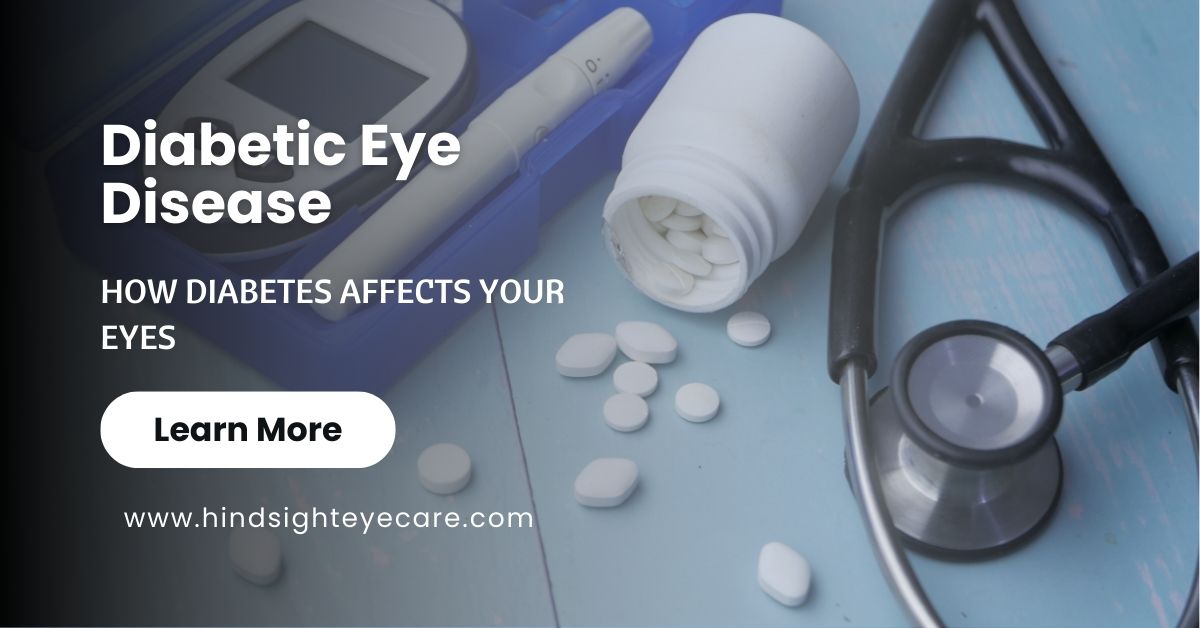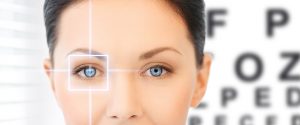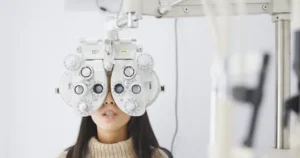Diabetic Eye Disease
According to the Centers for Disease Control (CDC), over 37 million Americans have diabetes. At Hindsight Eye Care, we’re committed to helping our patients understand the crucial link between diabetes and vision.
Diabetes is a condition that affects how your body processes food for energy. When you have diabetes, your body either doesn’t produce enough insulin or can’t use it effectively. This leads to high blood sugar levels, which can damage various parts of your body – including your eyes.
- Diabetic retinopathy is the leading cause of blindness in American adults.
- Adults with diabetes are 2-5 times more likely to develop cataracts at a younger age.
Dr. James Russell, our lead optometrist at Hindsight Eye Care, explains, “Many of our patients are surprised to learn just how much diabetes can affect their vision. It’s not just about needing new glasses; diabetes can lead to serious eye conditions that, if left untreated, may result in vision loss.”
How Diabetes Affects Your Eyes
Diabetes can impact your vision in several ways. Let’s break down the main eye conditions associated with diabetes:
-
Diabetic Retinopathy
Diabetic retinopathy is the most common diabetic eye disease. It occurs when high blood sugar levels damage the blood vessels in the retina – the light-sensitive tissue at the back of your eye.
There are two main stages of diabetic retinopathy:
- a) Non-Proliferative Diabetic Retinopathy (NPDR):
- Early stage of the disease
- Blood vessels in the retina weaken and may leak
- Can cause the macula (central part of the retina) to swell, leading to blurred vision
- b) Proliferative Diabetic Retinopathy (PDR):
- More advanced stage
- New, abnormal blood vessels grow on the retina
- These vessels are fragile and can bleed, causing vision loss
-
Diabetic Macular Edema (DME)
DME occurs when fluid builds up in the macula, causing it to swell and distort vision. This condition can develop at any stage of diabetic retinopathy and is a common cause of vision loss in people with diabetes.
-
Cataracts
While cataracts are a common part of aging, people with diabetes tend to develop them earlier and they progress faster. High blood sugar can cause the lens of your eye to become cloudy, affecting your vision.
-
Glaucoma
Diabetes nearly doubles the risk of developing glaucoma, a group of eye conditions that damage the optic nerve. One particular type, neovascular glaucoma, is directly linked to diabetic retinopathy.
-
Blurry Vision from Blood Sugar Fluctuations
Even if you don’t have a diagnosed eye condition, diabetes can still affect your vision. Rapid changes in blood sugar levels can cause the lens in your eye to swell, leading to temporary blurry vision.
Table: Common Eye Problems Associated with Diabetes
| Eye Condition | Description | Symptoms |
| Diabetic Retinopathy | Damage to retinal blood vessels | Floaters, blurry vision, dark areas in vision |
| Diabetic Macular Edema | Swelling in the macula | Blurred central vision, colors appear washed out |
| Cataracts | Clouding of the eye’s lens | Cloudy or blurry vision, difficulty seeing at night |
| Glaucoma | Damage to the optic nerve | Gradual loss of peripheral vision, eye pain |
| Blurry Vision | Temporary lens swelling | Fluctuating vision clarity |
How to Prevent and Manage Diabetic eye disease
The good news is that with proper care and management, you can significantly reduce your risk of diabetes-related eye problems. Here are some key steps:
-
Control Your Blood Sugar
Maintaining stable blood sugar levels is crucial for preventing eye damage. Work closely with your primary care physician to develop a diabetes management plan that works for you.
-
Regular Eye Exams
At Hindsight Eye Care, we can’t stress enough the importance of regular comprehensive eye exams. For people with diabetes, we recommend annual dilated eye exams to detect any changes early.
-
Manage Blood Pressure and Cholesterol
High blood pressure and cholesterol can worsen diabetic eye disease. Keep these in check with medication, diet, and exercise as recommended by your doctor.
-
Quit Smoking
Smoking can further damage blood vessels, including those in your eyes. If you smoke, talk to your doctor about cessation programs.
-
Protect Your Eyes from UV Rays
Wear sunglasses that block harmful UV rays, which can speed up cataract progression.
-
Maintain a Healthy Lifestyle
Eat a balanced diet rich in eye-healthy nutrients, stay active, and maintain a healthy weight to support overall eye health.
The Importance of Regular Eye Exams
Dr. James Russell, emphasizes, “For our patients with diabetes, comprehensive eye exams are not just about updating your eyeglass prescription. They’re a crucial part of managing your overall health.”
During a diabetic eye exam at Hindsight Eye Care, we use advanced technology to thoroughly assess your eye health:
- Retinal Imaging: We use state-of-the-art cameras to capture detailed images of your retina, allowing us to detect even subtle changes.
- Optical Coherence Tomography (OCT): This non-invasive imaging test provides cross-sectional pictures of your retina, helping us identify and monitor conditions like diabetic macular edema.
- Visual Field Testing: This helps us evaluate your peripheral vision, which can be affected by glaucoma.
- Tonometry: We measure your eye pressure to check for glaucoma.
- Dilation: By dilating your pupils, we can get a clear view of the back of your eye to check for signs of diabetic retinopathy and other conditions.
Treatment Options for Diabetic eye disease
If we do detect any diabetes-related eye problems, we have several treatment options available:
- Laser Treatment: For diabetic retinopathy, laser treatment can help seal leaking blood vessels and prevent new ones from forming.
- Anti-VEGF Injections: These medications can help reduce swelling in the macula and slow the progression of diabetic retinopathy.
- Vitrectomy: In advanced cases of diabetic retinopathy, this surgical procedure may be necessary to remove blood or scar tissue from the eye.
- Prescription Eyewear: We can provide specialized eyeglasses or contact lenses to help manage vision changes related to diabetes.
FAQs About Diabetic eye disease
To wrap up, let’s address some common questions we receive at Hindsight Eye Care:
Q: How often should I have an eye exam if I have diabetes?
A: We recommend annual comprehensive eye exams for most patients with diabetes. However, depending on your individual situation, we may suggest more frequent check-ups.
Q: Can diabetes-related eye problems be reversed?
A: While some effects of diabetes on the eyes can be treated, prevention is key. Early detection and management can help prevent or slow the progression of eye problems.
Q: Will I go blind if I have diabetes?
A: With proper management of your diabetes and regular eye care, the risk of severe vision loss is significantly reduced. Early detection and treatment are crucial.
Q: Can I wear contact lenses if I have diabetes?
A: Many people with diabetes can wear contact lenses safely. We’ll assess your individual situation and recommend the best options for you.
Q: Are there any specific foods that can help protect my eyes if I have diabetes?
A: A diet rich in leafy greens, colorful fruits and vegetables, and omega-3 fatty acids can support both your overall health and your eye health.
The Final Words!
At Hindsight Eye Care, we’re committed to helping our patients in The Villages maintain clear, healthy vision throughout their lives. If you’re living with diabetes, remember that you have the power to protect your eyesight. By partnering with us for regular eye exams and following your diabetes management plan, you can significantly reduce your risk of eye complications.
Explore more here: Contact Lenses vs. Eyeglasses: Which is Right for You After 50?




